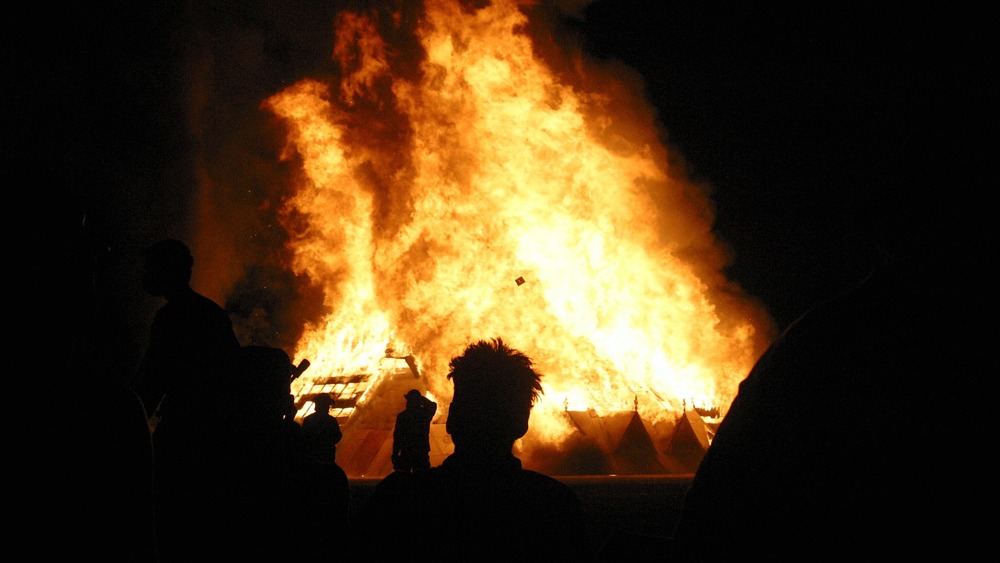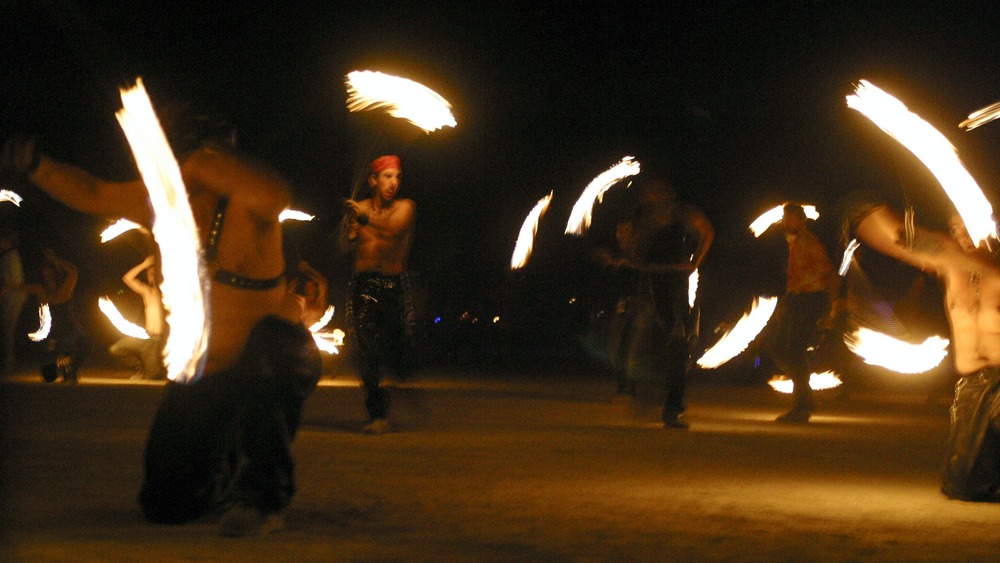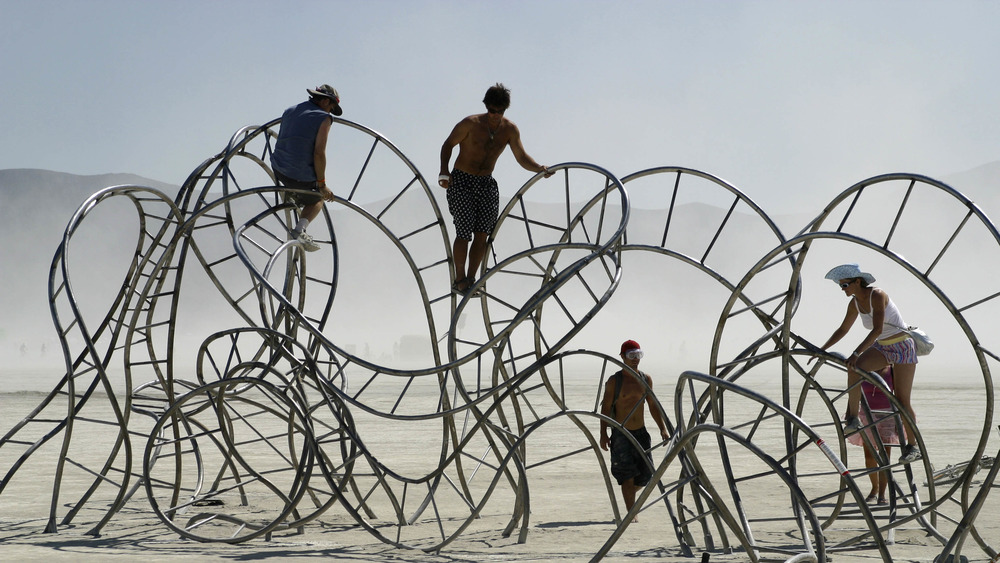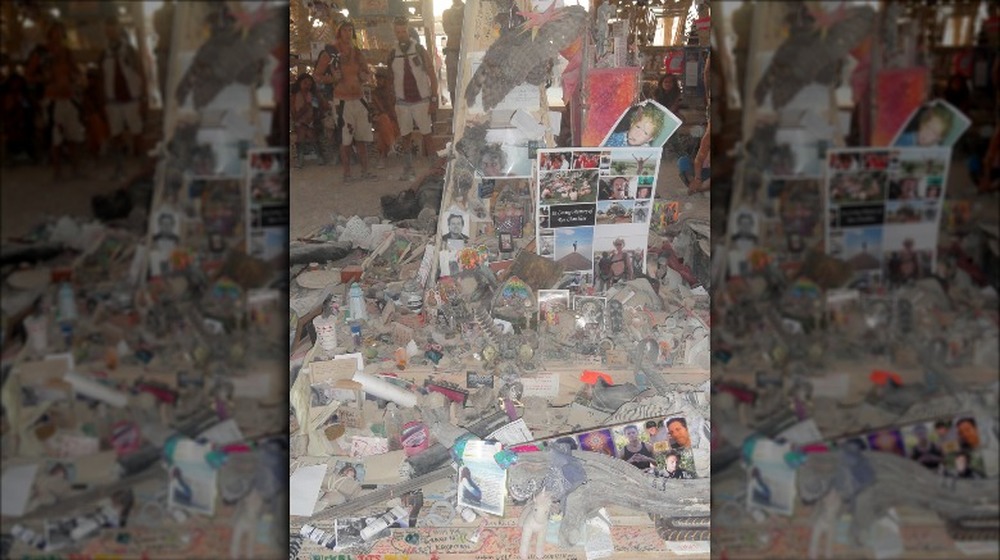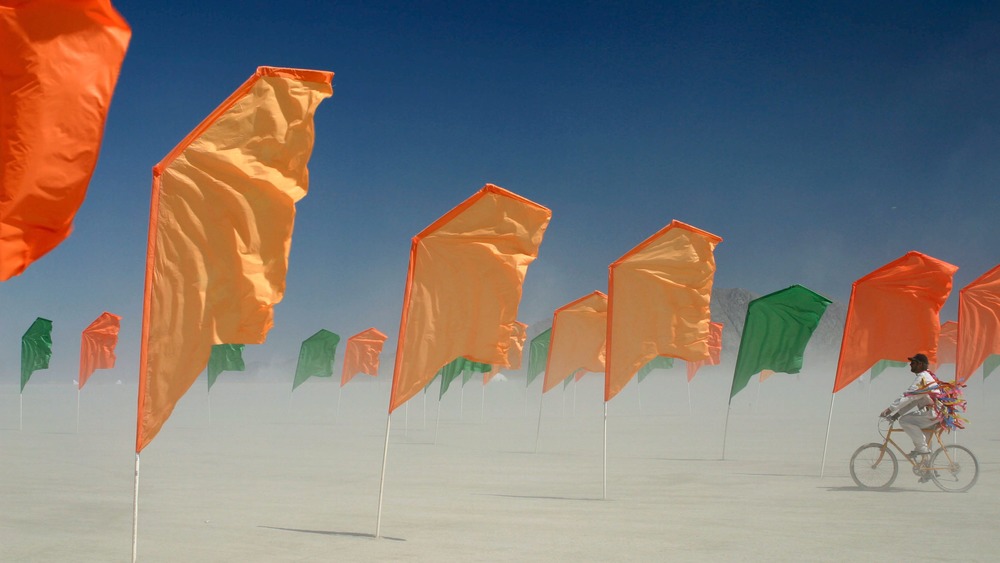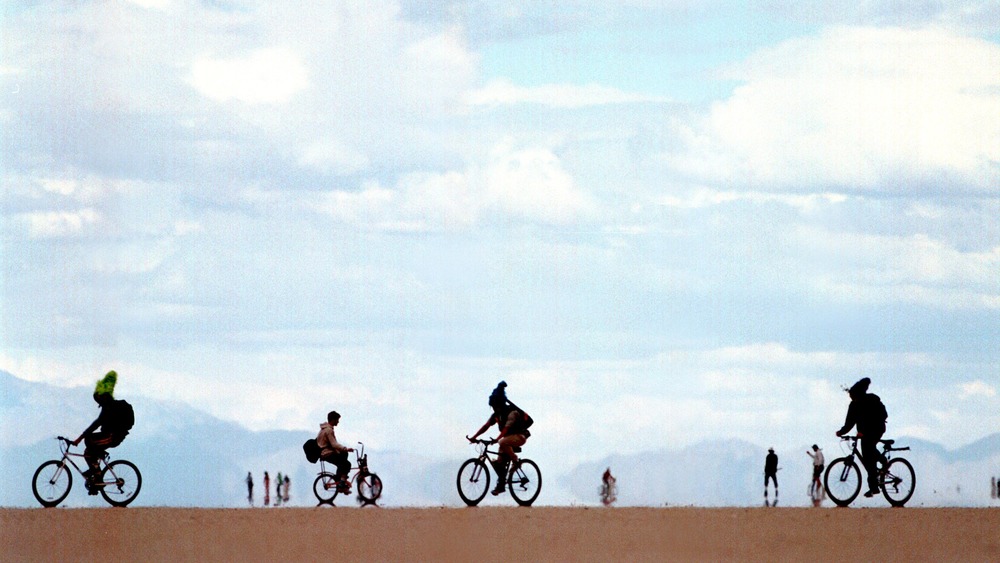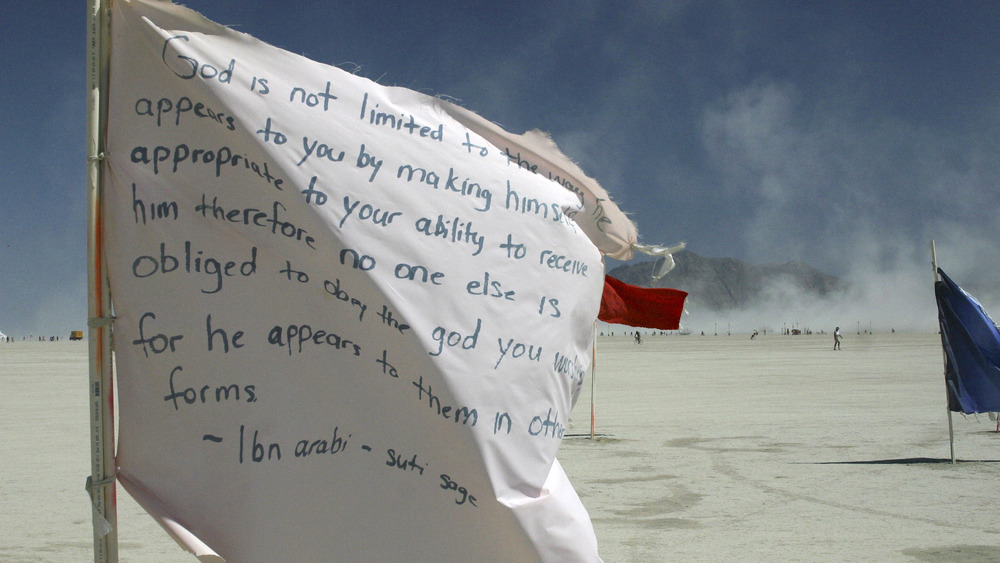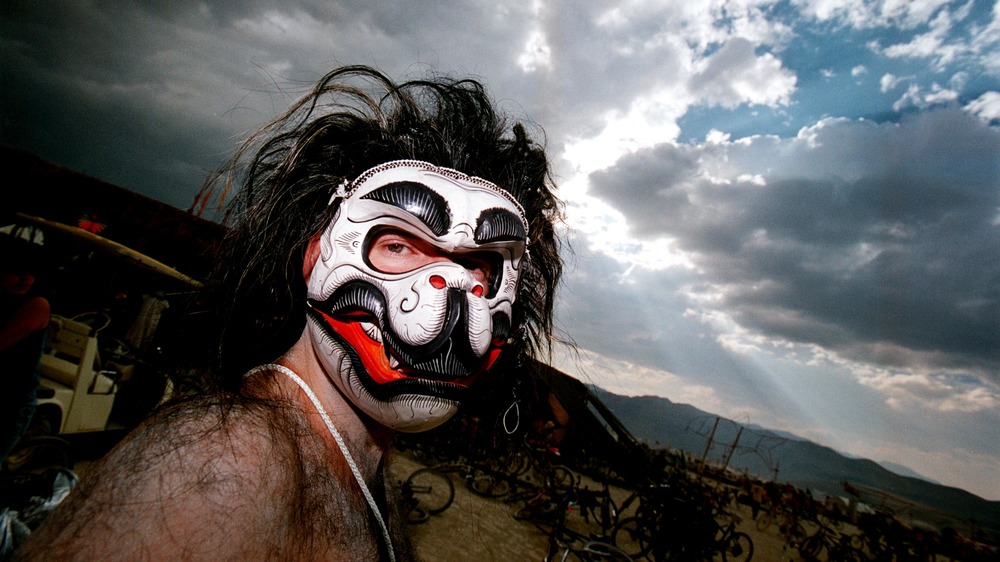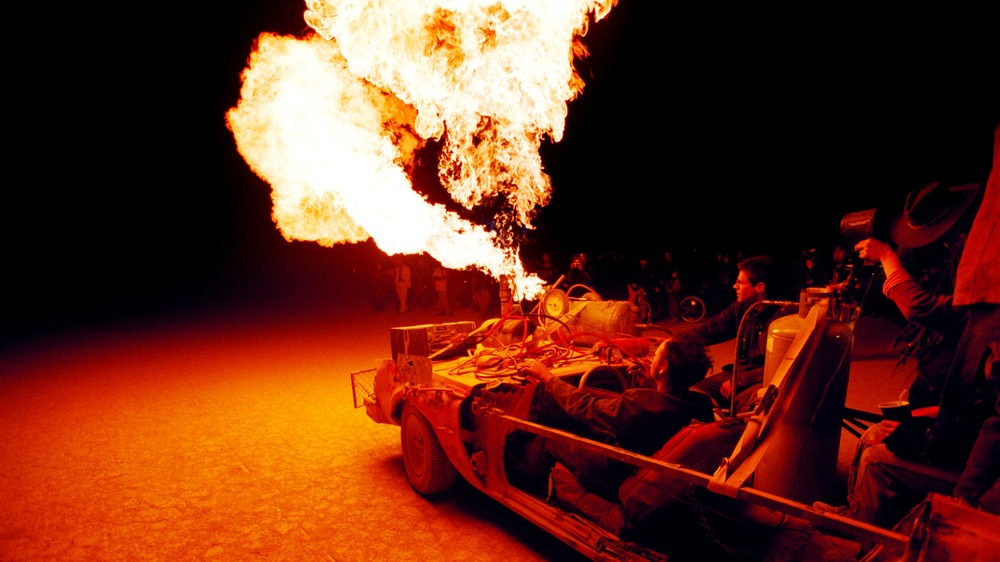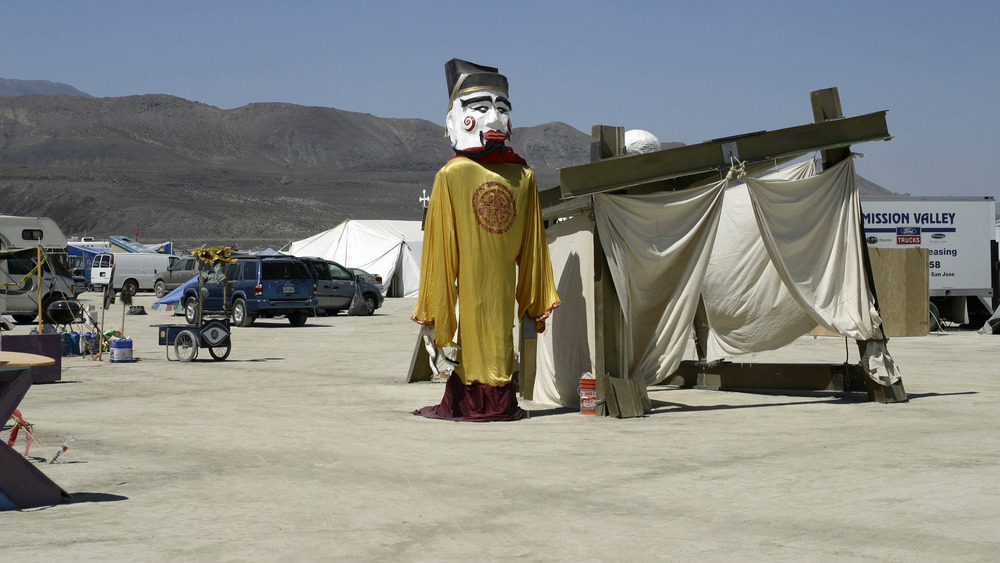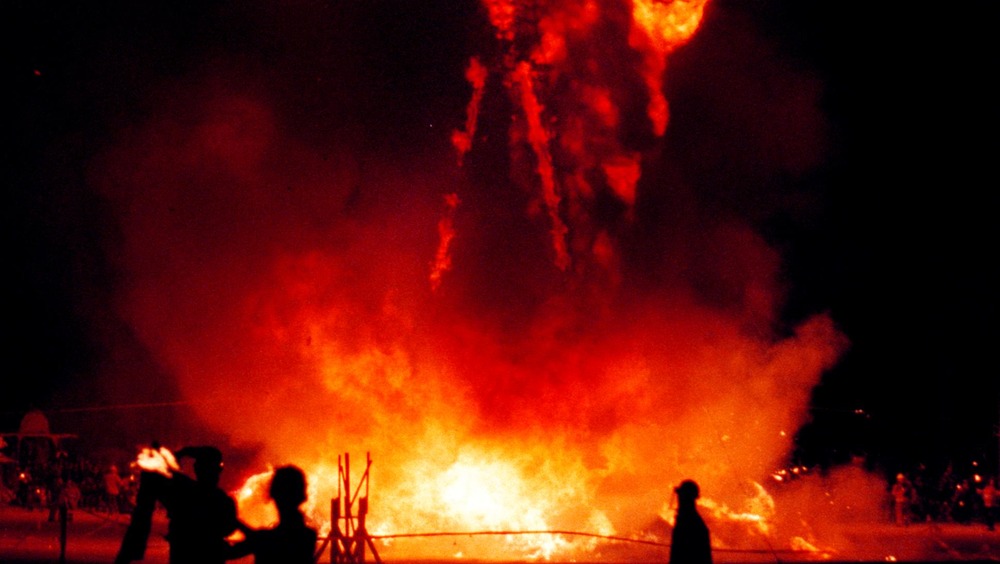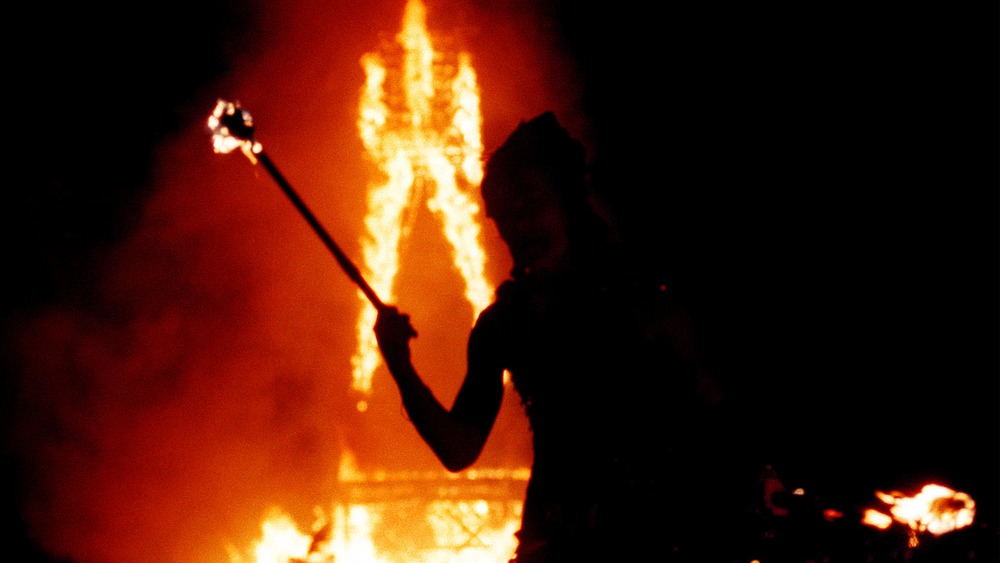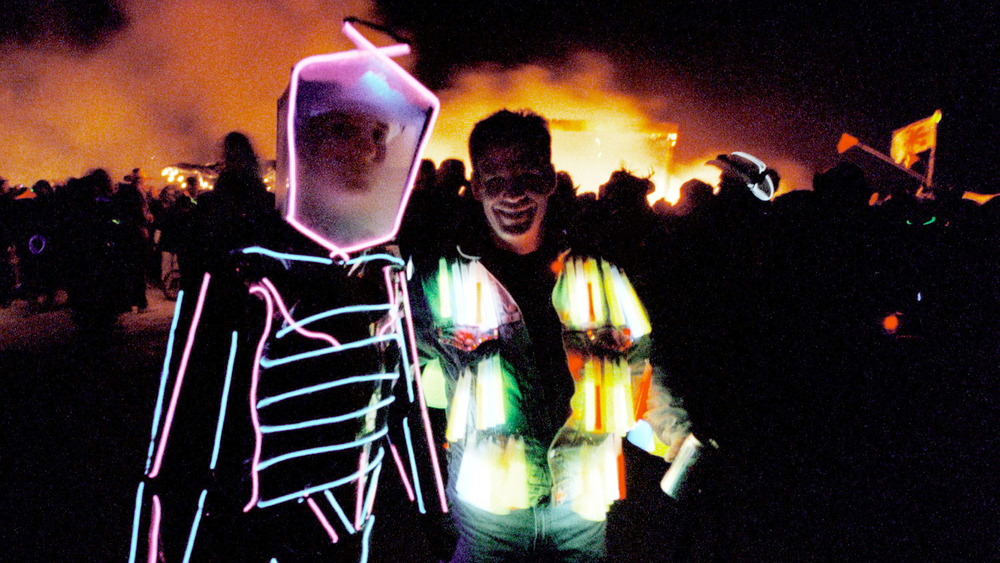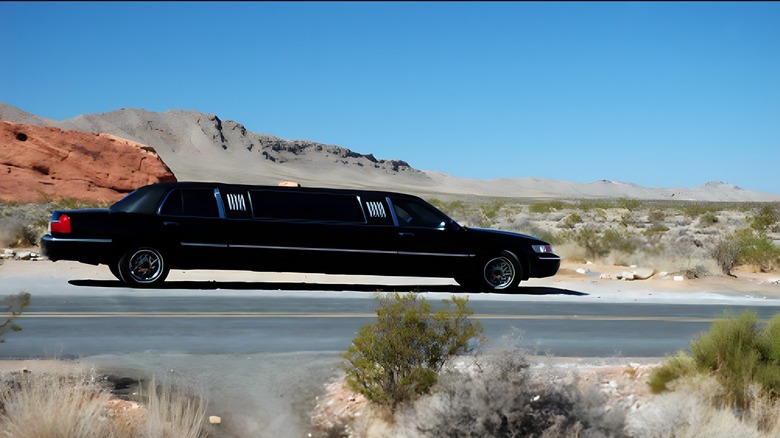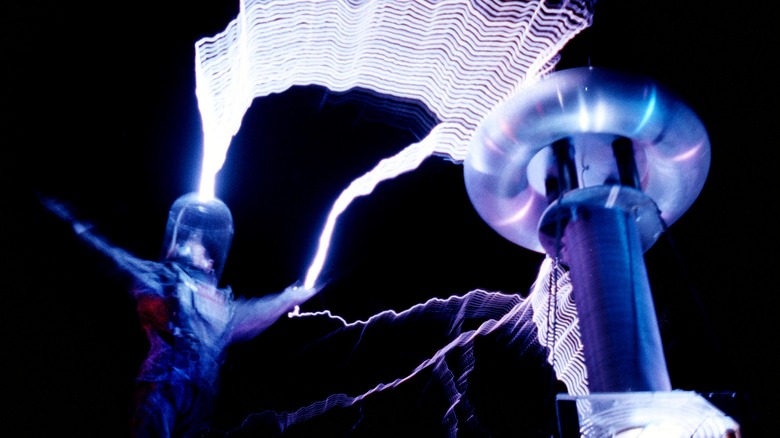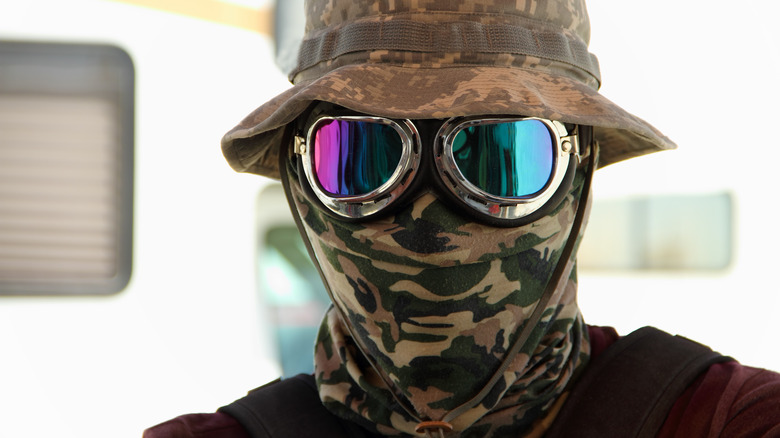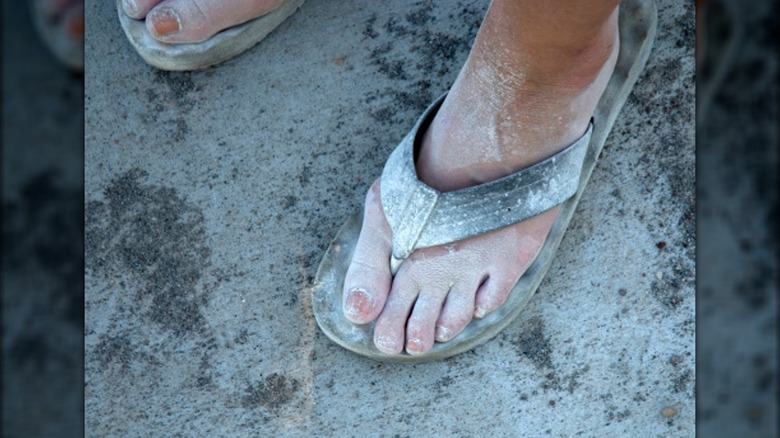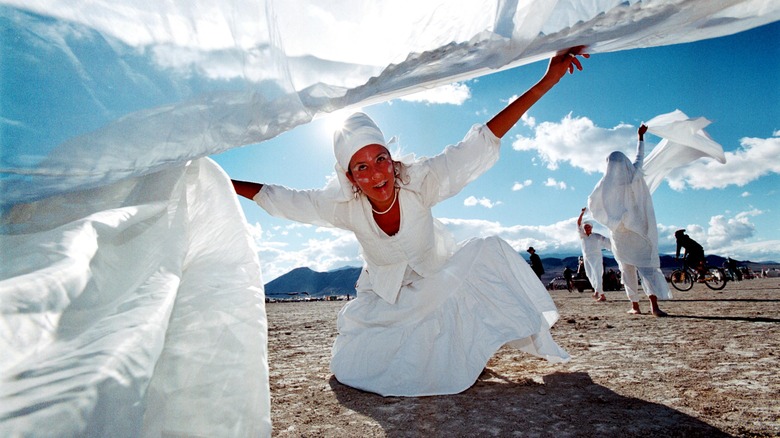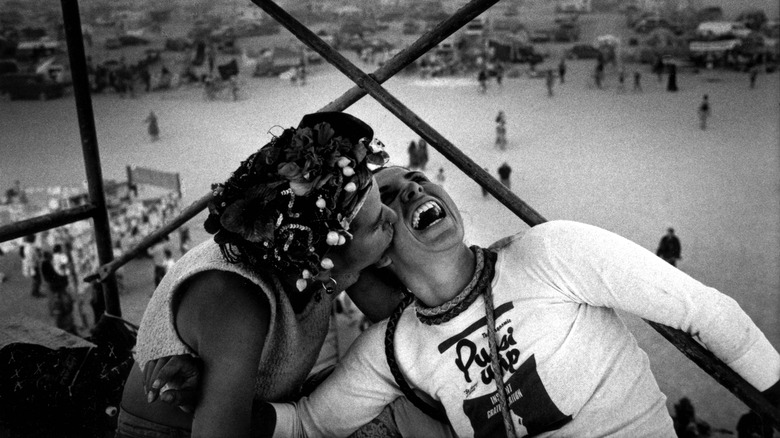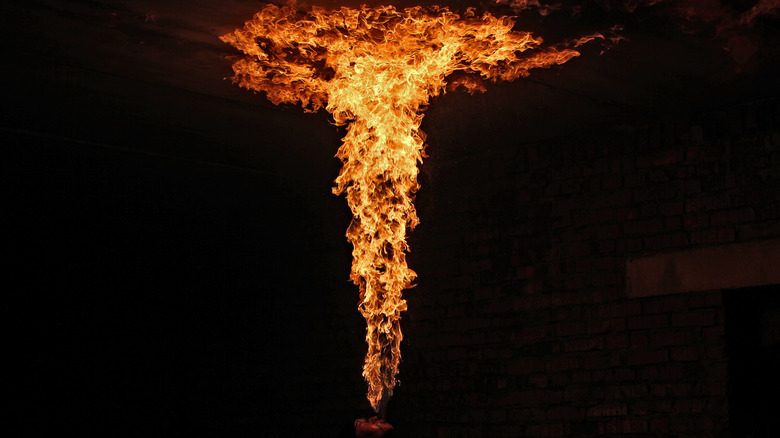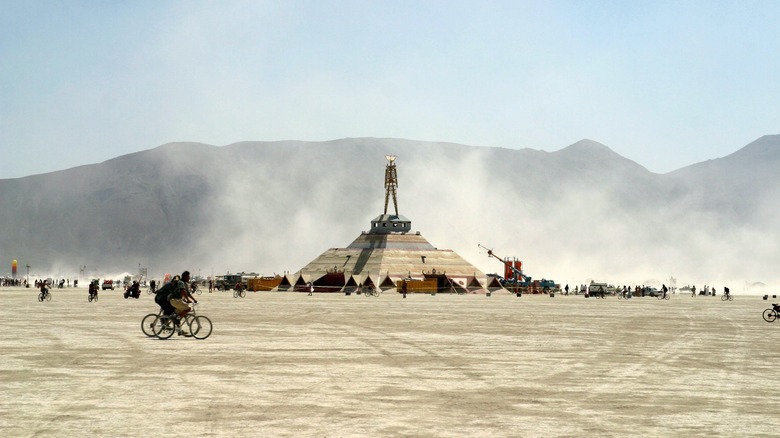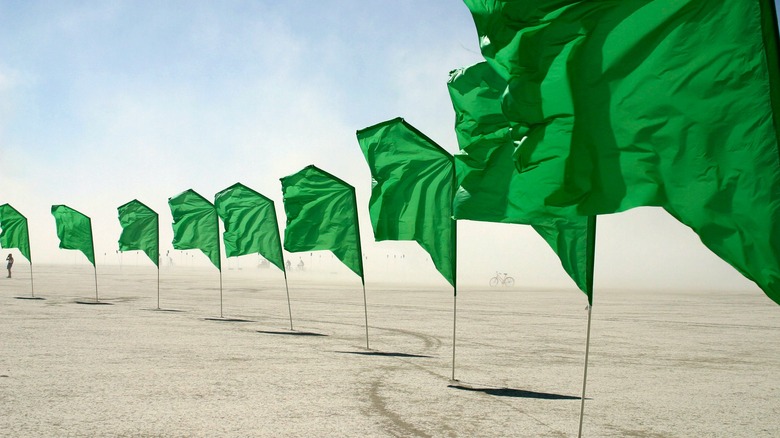The Untold Truth Of Burning Man
Burning Man is a well-known music event that has gained immense popularity over the years. The festival is widely described as unconventional and very different from its peers, but what can you expect at the event? An eclectic mix of artists and musicians, a vibrant atmosphere, the promise of a temporary escape, and an opportunity to meet other like-minded music enthusiasts.
While the festival is way more popular than it used to be, there are several tidbits about the festival that are worth delving into. For example, the space around Burning Man is known for being rather dusty and is basically not what you'd expect. It's not sand or dust, but it's actually leftover residue from a lakebed.
Another interesting fact? You're in luck if you're into astronomy, because the festival offers its attendees a chance to be a part of an observatory and catch glimpses of Saturn, Jupiter, and other fascinating sights. Tom Varden, who runs the initiative at Burning Man, said that you can have a major impact on someone if you treat them to a rare view like Saturn's rings. He added that it goes beyond just observing a remarkable sight. Varden said, "[When you show someone Saturn's views], they say things, they move, they get uncomfortable. It is exactly Burning Man."
It started as a bonfire ritual among friends
Believe it or not, Burning Man's origins were rather humble. It started as a small idea among friends that eventually got much bigger than originally intended. As an academic paper published in the Sacred Tribes Journal pointed out, the festival started with a really small number — around 20 attendees in San Francisco, California. The group got together in 1986, and the concept of the festival really started on a whim when two friends, Jerry James and Larry Harvey, decided to set fire to a wooden figure in an attempt to mark the summer solstice. Interestingly, Harvey was inspired by something he witnessed (via The New Republic.) An artist called Mary Grauberger would create sculptures and burn them, which intrigued Harvey and eventually inspired him to come up with Burning Man.
According to The Washington Post, Harvey was really moved by the fact that others joined him at the location and that they wholeheartedly supported the event. The enterprising Harvey ended up repeating the event the following year, which eventually led to the inception of Burning Man as we know it today. Per the festival's official website, the first event had an 8-foot-tall effigy that was greeted with a lot of enthusiasm from those who were there to witness it.
It became popular in just four years
After the first get-together, the event continued to become popular. In fact, by the time the fourth year rolled around, the festival was so popular that cops decided to pay a visit and interrupt the event. At that point, the wooden figure was massive — around 40 feet tall, at least.
Larry Harvey and his pals weren't discouraged in the least, and simply decided to change their location in order to continue with what they had planned. They went directly to the Black Rock Desert in Reno, Nevada, accompanied by a group called the Cacophonist Society. They continued the event in the middle of the desert and even ended up carrying out their signature burning ritual, coupled with other shenanigans — like racing in the desert at crazy speeds. Things were about to get crazier with the subsequent editions of the festival.
It became a way to remember lost loved ones
According to Inc.,, Burning Man offers a rare opportunity for attendees to remember their loved ones by visiting a temple at the festival. You can pen a letter to someone you're grieving for and leave a message. The temple is set on fire during the course of the festival, and many find the ritual incredibly touching and life-changing.
It's also recommended that you allow yourself time to mourn at the festival and write how you really feel instead of trying to do something beforehand. There is no pressure, and it really is up to you.
Per Burning Man's website, the temple is significant and symbolic in more ways than one. It's a highly spiritual space for visitors, and several attendees seek peace by writing down how they feel about their loved ones. There are no rules, and it's also acceptable to come up with a letter for yourself, to no one in particular, or anything else that catches your fancy. A description on the site explains it best, "Those who participate in this tradition often find that it works as a spiritual cleansing, a liberator of the mind, and a psychological release. What is for certain is that the temple always stirs awe and inspiration."
The festival has a set of principles
Burning Man has a list of ten principles that its loyalists tend to follow religiously. According to the festival's website, its principles include ideas like embracing the concept of giving gifts to other attendees at the event. It's an unconditional act that's performed without any expectations. Additionally, the festival has a strict policy that rejects commercialization.
Furthermore, Burning Man doesn't rely on things like advertising. As far as the festival is concerned, it's crucial to keep the true essence and spirit of Burning Man alive. Plus, the event relies heavily on its people and the sense of community they carry with them to keep the fire burning.
Participants are also heavily encouraged to respect rules and not violate any laws while attending the festival. Another principle is dedicated to the environment and the importance of safeguarding its beauty. As the site explains, "Our community respects the environment. We are committed to leaving no physical trace of our activities wherever we gather." They add that they make it a point to leave the area clean and spotless after the festival.
Burning Man is fairly diverse
Diversity has often been a big part of Burning Man. In fact, according to one of its ten principles, participants from varied backgrounds are encouraged to attend. A statement from the festival reads, "Anyone may be a part of Burning Man. We welcome and respect the stranger. No prerequisites exist for participation in our community."
This ideology runs somewhat counter to the common idea many people conjure up when festivals are mentioned. While, according to YouGov, people aged 30-44 are the largest festival-going group, the demographics are still skewed to the younger crowd. An Insider piece dove deep into the concept of inclusivity at Burning Man and explored the idea that no matter what your age is, you're welcome to be a part of the festival and celebrate with other participants. This means that you could be an elderly person or a child, and the doors will still be open for you.
The festival's popularity has caused controversy
Despite good intentions, Burning Man has run into controversies in the past and has been unable to ward off accusations that it has strayed away from what it originally stood for. As illustrated by The Guardian back in 2019, the festival was starting to suffer on account of the fact that many social media influencers were flocking to Burning Man and promoting brands at the festival, an act that definitely goes against its true spirit.
Complaints started to pour in from old Burning Man attendees, who pointed out that the festival was suffering from many setbacks, such as influencers taking over the event. Additionally, it was alleged that certain unfavorable camping groups had started making their presence felt at Burning Man, corrupting the event.
Burning Man took the complaints seriously and decided to ban a camp that promoted things like "yoga retreats" and "meditation and energy healing sessions." Burning Man's CEO Marian Goodell said, "Burning Man strives to stand in technicolor contrast to the typical consumerist, status-driven, brand-saturated, optimized-for-your-convenience world." He added that the team truly believes in the festival's original spirit and what it stands for, implying that the organization wouldn't ignore transgressions.
It has attracted attention from companies
Burning Man has received a lot of attention from tech companies. As reported by the Los Angeles Times, for example, for entrepreneur Shane Metcalf it was important to arrange Burning Man tickets for his employees. He hoped that the initiative would give members of his team a chance to be more creative and also feel more connected with each other.
Another company, Faceparty, in 2007, encouraged its employees to attend the festival and experience something new. While the experience was fascinating for many attendees, the company sadly experienced major setbacks later in 2008 and was forced to let go of many staff members. Additionally, many major players in the technology space, such as Tesla's founder Elon Musk, Garrett Camp from Uber, and Google's ex-CEO Eric Schmidt, have been a part of Burning Man in the past and showcased their support for the festival.
Burning Man and #MeToo
Burning Man ended up being involved in the controversial #MeToo movement. According to a 2018 Vogue piece, the story gets a bit complicated when it comes to sexual assault allegations at Burning Man. Turns out, a few attendees wanted to suggest a few changes to the way things worked at Burning Man even before the #MeToo movement took off. They wanted the founders to tweak the festival's principles to include consent.
A project was started in 2012 by those who'd been a part of the festival. One of the members from the project, Jaime Chandra, said, "We had some issues at our Burn ... and that same year, there were a ton of sexual assault reports from Black Rock City." As per Chandra, many attendees have sadly misused what Burning Man stands for to "take advantage of this culture of radical expression and inclusion" and act inappropriately with other attendees.
As reported by The New York Times, Burning Man has chosen to step up and address consent. The Burning Man website has several pieces that focus on ways to tackle sexual assault at the event. Participants at the festival are encouraged to turn to the services available at the event to seek help and report incidents. The website further states that the festival does not tolerate sexual harassment of any kind.
If you or anyone you know has been a victim of sexual assault, help is available. Visit the Rape, Abuse & Incest National Network website or contact RAINN's National Helpline at 1-800-656-HOPE (4673).
The take on economy is odd
While Burning Man doesn't stick to commercial activities, it has been unable to escape commodification in the outside world. Reno-Tahoe International Airport witnesses the arrival of many festival attendees every year from different parts of the world, making it an incredibly busy time for those working at the airport. It is believed that the airport gets as much as $10 million every year thanks to those heading to the festival.
Larry Harvey, to his credit, did address the fact that Burning Man does fall prey to commercial activities. Additionally, he explained what goes on behind the scenes. He said (via The Atlantic), "They say that because we have a principle of decommodification, that we're against money. But no, it's not really about money." He added that he doesn't discount the fact that the team needs to rely on market economics to make the event happen in the first place. The team does have solutions — it uses tools such as crowdfunding to make the event successful and to put up its glorious art installations every year.
You can even make a call to God
Make no mistake — Burning Man fully lives up to its image when it's supposed to. As The Guardian pointed out, it's possible to actually make a phone call to God at the event and pour out your heart. Volunteers pick up and allow you to share whatever is on your mind.
A Redditor recounted the experience and wrote about what it was like to talk about their feelings. They wrote, "I stumbled upon the talk to God phone booth and it made me smile." They couldn't help but feel curious and picked up the phone, crying when they heard someone talking to them on the line. The conversation moved to the Redditor's late brother and left them feeling understood and at peace. They added, "That was the most cathartic and healing experience I've ever had ... I look back on it all the time and smile." A commentator shared their encounter with the booth and wrote that they were struggling and couldn't make up their mind about shifting base to a different city. The conversation ultimately helped them make the difficult decision.
You can, of course, talk to other attendees at the event and engage in discussions on a variety of topics without worrying about being judged. Nothing is out of bounds, and you can choose to have heavy discussions or talk about something bizarre, if that's what your heart desires.
The music has evolved
Burning Man is not a boring or predictable event at all. As far as music at the event is concerned, plenty of changes have been embraced by Burning Man. The event has welcomed all kinds of artists to its festivities, including popular DJs like Armin Van Buuren, Tiesto, and Skrillex, among others. It's impossible to get bored — you'll be treated to a variety of music and will find something that truly appeals to you.
As a Billboard piece pointed out, electronic music is a big deal at the event. A long-time loyalist, Syd Gris, who started a popular sound camp at the festival, believes that the festival has seen massive changes. For example, many high-profile DJs are now sought after, and that is a bittersweet pill to swallow. He explained why he supported this move himself and recounted a memorable experience. He said, "Having Tiesto play your camp in 2005 when he was big but not the monster he is now, and he was still playing what I would consider great progressive trance, that was magical and everyone that was there that night experienced a little piece of magic."
That said, he admitted that Burning Man sometimes misses out on the raw talent that unknown DJs can bring to the festival.
There was a private Burning Man in 2020
The COVID-19 pandemic affected many things in 2020, including Burning Man's annual celebration. While the event was officially called off on account of the pandemic, a few enthusiasts decided to go ahead with private celebrations of their own. As reported by Vulture, scores of Burning Man loyalists ended up flocking to Nevada around the end of August. Of course, it helped that the desert is vast, and attendees could practice social distancing without stressing over the logistics.
One of the organizers said that the team tried their best to keep things as safe as possible. They said, "People made the decision to come here during a global pandemic. So we decided to keep people's camps 200 feet away from one another and to advise wearing masks when meeting others" (via NBC News 4).
Technically, Burning Man chose to organize its events online in 2020, but of course, some festival-goers still went to the Black Rock Desert. The official team didn't organize the event, which was called "Not Burning 2020," and had at least 1,000 participants at the venue.
Billionaires have been blamed for ruining Burning Man
For years, Burning Man has been a hippie's dream come true, where like-minded souls gathered for days of art, music, and the sort of old-school fun that didn't need anyone to blow their life savings on the experience. By 2023, though, that had changed to the point where CNN observed: "billionaires ruined Burning Man." How? When the 1% show up with their personal chefs and luxurious tents kitted out with chandeliers, well, that's the opposite of the point.
In 2019, Burning Man CEO Marian Goodell posted on the changing culture of Burning Man, and shared just how disappointing it was — particularly with the rise of Instagram influencers and luxury camps. One — Camp Humano — was outright banned from attending future events, and around a dozen others were warned. What was Camp Humano? A luxury tent with air conditioning and all the creature comforts of a one-percenter home, with numbers like "$100,000" thrown around for pricing.
Some condemned Goodell's reaction as a "too little, too late," sort of thing, saying that people like Elon Musk and Mark Zuckerberg had been leading the festival down the path to ruin for a long time. It wasn't just the outrageous prices, either, and the BBC quoted Burners who were disillusioned by the commercialism, the branding, the marketing, and one Redditor summed things up like this: "Arguably the biggest loss is the freedom people feel on the playa to express themselves. As cameras are becoming so common it makes a lot of burners wary."
It's had a surprising impact on the culture of Silicon Valley
Burning Man-style art and technology might seem like they're at opposite ends of the creativity spectrum, but Stanford professor Fred Turner has done some fascinating work looking at how the festival's culture has had an invaluable and long-lasting impact on the tech world of Silicon Valley. His interest, he explained, was in the crossover between tech and art, sparked by the fact that Google's office walls are filled with photos from Burning Man; there was an obvious connection there.
The connection was actually pretty straightforward, and Turner says that the anything-goes, outside-the-box, collaborative creativity that's fostered in Burning Man projects is precisely what Silicon Valley tapped into to create the technology that exists today. Turner explained: "The collaborative, project-centered building and play that Burning Man supports help build social and professional networks of folks who come together back here in Silicon Valley and make things."
There were a few more layers to it, too. Both Burning Man and Silicon Valley present unique challenges with no road map, strict deadlines, difficult conditions, and force people to work together to create something that's then sent out into the world. (Or, in the case of Burning Man, celebrated by others on the playa.)
Some of those revelers might be FBI agents
Burning Man might seem like the perfect place for any free spirits who prefer going barefoot to wearing dress shoes, but it turns out that not only has it become a go-to for the ultra-wealthy, but some of those Burners might just be undercover FBI agents. That's what MuckRock discovered after filing a Freedom of Information Act request in 2012, and then being granted access to heavily redacted documents.
The documents outline the Bureau's initial thoughts for investigating the festival, including their greatest concerns: "crowd control issues and use of illegal drugs by the participants." Things seem to have started in 2010, when an unnamed party had reached out to a private security firm to ask them "to conduct a threat assessment," which doesn't seem unreasonable given the sheer number of people there. But it doesn't seem to have ended there, and the documents also suggest that the Bureau had continued to keep an eye on Burning Man via undercover agents.
Along with notes on approving overtime for agents tasked with working "special events," part of a 2010 memo suggests that Burning Man presented a unique opportunity for agents to work alongside other law enforcement agencies, further specifying: "[to] aid in the prevention of terrorist activities and intelligence collection. ... This case will serve as a platform to address such matters if they arise at this event."
The dust that covers everything is really weird
Take a look at almost any photos from Burning Man, and a few things will stand out (aside from the "Mad Max" vibe). It all looks very hot, very dry, and very dusty, and the festival even has official guidelines on how to deal with the dust. Key? It's super important to get it off all your things ASAP. Not only will it make your skin, nose, and throat painfully dry, it'll seriously damage any tech, stain anything that's stainable, corrode anything that's corrodible, and turn your bike into a creaky pile of gears and chains. And then there's Playa Foot, which is a condition that essentially leaves chemical burns on revelers' feet. Vinegar, is supposed to be one of the only things that'll really neutralize it, so what gives?
The entire area that's turned into Burning Man every year actually has a very cool history, especially going back to 2.5 million years. It was originally a lake, but then this ancient mammoth stomping ground dried up somewhere around 11,700 years ago and left dust that's so alkaline it's damaging.
But, there's good news! The Reno Gazette-Journal spoke with Northern Nevada Medical Group pulmonary specialist Dr. Aleem Surani, who confirmed that breathing the dust for the few days of Burning Man wouldn't likely cause any long-term problems. That said, those masks aren't just for looks, and anyone with pre-existing conditions should take extra precautions.
It's not cheap
With a complete lack of fancy hotels, car rentals, and restaurants, it might seem like Burning Man would be a great, affordable trip. Just grab some camping gear, and go ... right? It's not that simple anymore, and in 2023, SFGate took a look at just how much it would cost to attend. (For a normal person, that is.) They stress that actually, Burning Man does start with hotels, car rentals, and restaurants, judging by the approximately $60 million that out-of-towners invest into the local economy each and every year.
Ticket prices depend on how they're purchased, and range anywhere from $575 to $2,750. That's a given, along with the $150 parking fee. Most Burners will also be forking over some cash to carve out a niche for their campsite, and that varies widely: Some places are free, whereas some will set you back as much as $5,000. How much a Burner spends on their gear varies, too, with many saying that their spending is comfortably in the few-thousand-dollars-range, adding in bike purchase or rental, transportation to and from the nearest city (120 miles away), and post-festival clean-up.
The BBC interviewed a few people who had gone, and found that while one got away with spending a relatively small $1,500 for her trip, others hovered in the $4,000 to $8,000 range. That can easily hit the $10,000 mark, but at least your gear is reusable for next year, right?
It takes a toll
The concept of biological age is pretty interesting stuff. It's basically the idea that everyone — and all parts of everyone — ages independently of the calendar, depending on factors such as genetics and lifestyle. GQ interviewed tech guru Brian Johnson, who sold his business for millions and turned to work on prolonging his life. Years of effort have given him the heart health of someone ten years younger than his 45-year calendar age, for example. Getting there isn't easy, and is a job in itself. Mainstream medical research has confirmed that biological age is a thing, and here's where Burning Man comes in.
InsideTracker is a biometrics tracker that measures the impact that your choices — from food to sleep schedule — have on the efficiency and health of your body. In 2021, Erin Sharoni used their InnerAge algorithm to estimate her biological age before and after Burning Man ... and maybe Brian Johnson should stay away from this particular festival.
Her biological age increased by a whopping 21 years during her time at Burning Man, and when she broke things down by the numbers, she found that elements like the extreme temperatures and lack of humidity had drastically impacted things like her glucose, cortisol, and iron levels. She was also in a pretty bad bike accident that didn't help, but her takeaway? "You have one life to live, and enjoying it is as critical as anything else."
How one man was charged with arson for burning the man at Burning Man
In recent years, purists have condemned the direction that Burning Man is moving in, but it turns out that's nothing new. In 2007, Burning Man's iconic burning man effigy was the target of a little pre-burn arson. The Reno Gazette-Journal says that people had always been trying to set it on fire ahead of schedule, because people are people and fire is neat, but Paul Addis was arrested, convicted, and released on parole after serving two of his four-year sentence.
In a 2007 interview with Wired, Addis said that although he couldn't take credit for the early burn (his court case was still in process), he did say that he understood the motivation behind it. Addis said that originally, Burning Man was filled with "A lot of people [who] were very interested in making sure the future of America was better than the past." That, he said, ended when Burning Man fell into financial difficulties, and sacrificed idealism for cash. "Burning Man doesn't accomplish anything anymore. What do we get out of Burning Man? Nothing."
Addis continued to claim that he'd done it because he'd loved the festival and wanted to help it find a way back to the old days, but that wasn't the end of his story. In 2008, he was given court-ordered counseling after carrying a backpack of fireworks into a San Francisco church, and in 2012, SFGate reported that he had died by suicide.
Sustainability ... carbon negative ... so they say, but it's wildly eco-unfriendly
When Paul Addis condemned Burning Man for being too commercial and made his point by attempting a little 2007 arson, he told Wired that he was also mad at the year's Green Man theme: He condemned it for being anything but green in the environmentally friendly sense, saying, "Green Man is all about Burning Man getting the most green in their pockets." Was he right? Fast forward to 2023, and Wired says that he was. In spite of entire camps based around sustainability, composting, and vegan food, most of Burning Man was anything but sustainable.
Instead, it was populated by RVs burning gasoline in a big way, and there was also the biggest power drain of all: air conditioning. At the time, there was only a single solar-powered camp, and they could only do it because they had $200,000 of equipment. They were the exception, and the bottom line was that the average carbon footprint of a single Burner was twice what an average American put out.
Those behind Burning Man say they're trying to swing things back toward sustainability, but also in 2023, The Washington Post reported on an interesting lawsuit filed by the Burning Man Project. They were suing to stop a geothermal project from going ahead, claiming it would negatively impact nearby hot springs ... although the project was part of the government's clean energy initiatives.
Leave no trace? Locals say otherwise
A crucial part of the Burning Man ethos has always been "Leave no trace," and while that seems pretty straightforward, it's anything but. After rain turned 2023's burn into a muddy nightmare, the playa was abandoned en masse. An update from the Burning Man Project gave a massive shout-out to everyone who returned to help clean up the playa, saying that many people retreated, regrouped, and then came back to clean. That's great, but comments left after the update on the Burning Man Project journal suggest that's not the end of the story.
"Yep your trash is all scattered in Fernley, Fallon and Reno. Totally disgusting," read one. "The trash is scattered all the way to Gabbs, Tonopah, and even Beatty," read another. "Cars trailers campers wheels, and tires and trash. Left right where it falls. Disgusting and shameful," they continued.
KUNR says that's nothing new, and that although the playa might be cleared of everything — down to hairs, fibers, and pieces of glitter — trash is all too often dumped on the side of the road, despite massive signs warning of the penalties for illegal dumping. Local business owners feel it, too, with some needing to book entire dumpsters to deal with the trash left in their parking lots. SFGate spoke to business owners like Mark Lowenstern of Cross Roads Car Wash, who said, "... they treat my business like a public dump," and others said the same thing occurred at Donner Memorial State Park. Leave no trace on the playa, maybe.
